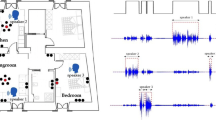Abstract
An important step to bring speech technologies into wide deployment as a functional component in man-machine interfaces is to free the users from close-talk or desktop microphones, and enable far-field operation in various natural communication environments. In this work, we consider far-field automatic speech recognition and speech activity detection in conference rooms. The experiments are conducted on the smart room platform provided by the CHIL project. The first half of the paper addresses the development of speech recognition systems for the seminar transcription task. In particular, we look into the effect of combining parallel recognizers in both single-channel and multi-channel settings. In the second half of the paper, we describe a novel algorithm for speech activity detection based on fusing phonetic likelihood scores and energy features. It is shown that the proposed technique is able to handle non-stationary noise events and achieves good performance on the CHIL seminar corpus.
Preview
Unable to display preview. Download preview PDF.
Similar content being viewed by others
References
Brandstein, M., Ward, D. (eds.): Microphone Arrays. Springer, Berlin (2000)
Li, Q., Zheng, J., Zhou, Q., Lee, C.-H.: A robust, real-time end-point detector with energy normalization for ASR in adverse environments. In: Proceedings of IEEE International Conference on Acoustics, Speech, and Signal Processing, pp. 233–236 (2001)
Martin, A., Charlet, D., Mauuary, L.: Robust speech/non-speech detection using LDA applied to MFCC. In: Proceedings of IEEE International Conference on Acoustics, Speech, and Signal Processing, pp. 237–240 (2001)
Padrell, J., Macho, D., Nadeu, C.: Robust speech activity detection using LDA applied to FF parameters. In: Proceedings of IEEE International Conference on Acoustics, Speech, and Signal Processing (2005)
Macho, D., et al.: Automatic speech activity detection, source localization, and speech recognition on the CHIL seminar corpus. In: IEEE International Conference on Multimedia & Expo., Amsterdam, Netherlands (2005)
Ramabhadran, B., Huang, J., Picheny, M.: Towards automatic transcription of large spoken archives – English ASR for the MALACH project. In: Proceedings of IEEE International Conference on Acoustics, Speech, and Signal Processing (2003)
Povey, D., Kingsbury, B., Mangu, L., Saon, G., Soltau, H., Zweig, G.: fMPE: discriminatively trained features for speech recognition. In: Proceedings of IEEE International Conference on Acoustics, Speech, and Signal Processing, vol. 1, pp. 961–964 (2005)
Fiscus, J.G.: A post-processing system to yield reduced word error rates: recognizer output voting error reduction (ROVER). In: Proceedings of the 1997 IEEE Workshop on Automatic Speech Recognition and Understanding, pp. 347–354 (1997)
Monkowski, M.: Automatic gain control in a speech recognition system. U.S. Patent 6, 314,396 (November 6, 2001)
Macho, D.: Speech activity detection: summary of CHIL evaluation run #1 (January 2005), http://chil.server.de/servlet/is/3870/
Author information
Authors and Affiliations
Editor information
Editors and Affiliations
Rights and permissions
Copyright information
© 2006 Springer-Verlag Berlin Heidelberg
About this paper
Cite this paper
Chu, S.M., Marcheret, E., Potamianos, G. (2006). Automatic Speech Recognition and Speech Activity Detection in the CHIL Smart Room. In: Renals, S., Bengio, S. (eds) Machine Learning for Multimodal Interaction. MLMI 2005. Lecture Notes in Computer Science, vol 3869. Springer, Berlin, Heidelberg. https://doi.org/10.1007/11677482_29
Download citation
DOI: https://doi.org/10.1007/11677482_29
Publisher Name: Springer, Berlin, Heidelberg
Print ISBN: 978-3-540-32549-9
Online ISBN: 978-3-540-32550-5
eBook Packages: Computer ScienceComputer Science (R0)




